As my colleagues have explored in previous blog posts, including this article on how to write a persuasive need statement, using accurate data in your proposals is a cornerstone of successful grant writing. However, not all data is the same. One critical yet often overlooked area is grant program data—the information related to donor details, application deadlines, submission tracking, and funding history. Managing this data effectively ensures nonprofits can strengthen relationships with grantmakers, prioritize their focus, improve their application strategy, and secure more funding.
Despite its importance, many nonprofits struggle to track and utilize grant program data efficiently. As a Project Coordinator at Elevate, I work every day to ensure my clients have clear, accurate data to support decision-making and ensure their grant programs run smoothly. In this blog, I will explore why it matters and provide actionable tips from my experience with several organizations to help nonprofits improve their grant data management.
Why Grant Program Data Matters in Grant Writing
Strengthening Relationships with Grantmakers
When grantmakers can see that their grantees are organized and strategic in their interactions, it engenders trust and confidence in the nonprofit. Tracking key details such as past funding amounts, reporting deadlines, and communication history – and using these data points to make decisions about how to approach a grantmaker – helps organizations tailor proposals and maintain strong relationships.
For example, some funders won’t allow you to submit a proposal for a renewal grant without submitting a final report, and often that reporting information can be found in the weeds of a grant agreement. When this type of information is tracked properly it helps to avoid missed opportunities for financial support.
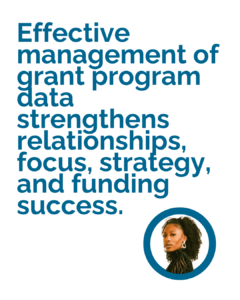 For example, one Elevate client had gaps in their grant calendar where they should have had grant report deadlines. We discovered this was due to missing and poorly tracked grant agreements – where the information about reporting requirements could be found! This information gap led to several missed report deadlines, putting our client’s funder relationships at risk and delaying new funding (because reporting was required before grants could be renewed.) Once we discovered the source of the missing information, we were able to compile and organize grant agreements and pull reporting deadlines and requirements from those documents to fill those crucial gaps in the calendar.
For example, one Elevate client had gaps in their grant calendar where they should have had grant report deadlines. We discovered this was due to missing and poorly tracked grant agreements – where the information about reporting requirements could be found! This information gap led to several missed report deadlines, putting our client’s funder relationships at risk and delaying new funding (because reporting was required before grants could be renewed.) Once we discovered the source of the missing information, we were able to compile and organize grant agreements and pull reporting deadlines and requirements from those documents to fill those crucial gaps in the calendar.
Beyond maintaining relationships, tracking interactions with grantmakers allows nonprofits to personalize their approach. By logging notes from conversations with program officers, feedback on proposals, and preferences about how and when requests are made, organizations can refine their applications to align with a funder’s priorities.
Another nonprofit that Elevate worked with was fortunate to work with a gracious program officer who was willing to provide feedback on our application in advance of our submitting it. By addressing this feedback in our application, we significantly strengthened our chances of securing funding. And, because the grantmaker was aware of our client’s intent to submit a request, the application was expected which further increases the likelihood of grant allocation.
Improving Application Success Rates
Nonprofits that manage their grant program data effectively can refine their application strategies. By analyzing data on past submissions, organizations can identify patterns—such as which types of requests are most successful (e.g. program restricted requests vs. general operating requests) or which types of grantmakers tend to fund similar projects.
Another key benefit is the ability to analyze rejection trends. If an organization sees a pattern of rejections from a specific type of funder, they can reevaluate how to frame their applications or shift focus to better-aligned funding sources. Proactively assessing past grant performance enables smarter, more targeted outreach. (Also check out this blog post for what to do when a grant is declined!)
For example, one Elevate client applied for a grant several times and was not awarded funding. They decided to shift their efforts instead to new funding opportunities and won a grant from an organization they had not previously partnered with. This was a great way to utilize data on the organization’s history with a grantmaker (i.e. multiple rejections) to determine whether an opportunity is worth pursuing again in the future.
Avoiding Missed Deadlines and Compliance Issues
Deadlines and reporting requirements vary across grantmakers. Missing a deadline—or failing to submit required reports—can jeopardize future funding opportunities. Beyond deadlines, tracking compliance requirements, such as submitting receipts or financial statements, ensures that nonprofits meet all necessary reporting expectations. Some funders require extensive narrative progress reports, while others focus on financial accountability. Having a centralized data system helps organizations quickly retrieve the necessary documents when requested, reducing stress and improving efficiency.
Common Challenges in Grant Data Management
Disorganized or Incomplete Records
Many nonprofits store grant information in multiple locations—spreadsheets, emails, or even paper files—leading to gaps and inconsistencies. This is especially true when a team member who is holding critical information leaves the organization or needs to be away unexpectedly. A centralized system ensures all relevant details are easily accessible and up to date.
Some organizations struggle with inconsistency in data entry, with different team members tracking information in different formats. Establishing a standardized method can ensure data remains accurate and easy to interpret. This can be as simple as having standard naming conventions for documents or folders organized by year and grantmaker. Consistency is key!
Loss of Institutional Knowledge
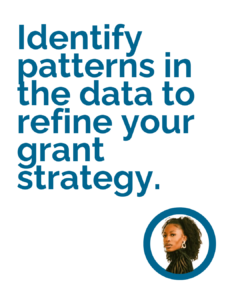 Staff turnover can lead to the loss of critical grant program data. Without a structured system, new team members may struggle to pick up where others left off. Establishing clear documentation, standards, and processes mitigates this risk and allows for smoother transitions between teams.
Staff turnover can lead to the loss of critical grant program data. Without a structured system, new team members may struggle to pick up where others left off. Establishing clear documentation, standards, and processes mitigates this risk and allows for smoother transitions between teams.
An Overwhelming Volume of Data
Some organizations collect excessive information without a clear strategy for its use. Prioritizing key data points such as funding cycles, grant amounts, feedback notes, and reporting requirements—prevents information overload.
Nonprofits should also focus on actionable data that directly impacts their ability to secure funding. Instead of tracking every minor interaction, prioritizing key engagement milestones, funding patterns, and funder preferences ensures the most relevant insights are easily accessible. Adding dates to these interactions and the point of contact can help track the lifespan of these organizational interactions.
Best Practices for Managing Grant Program Data
Standardize Data Entry and Tracking
Establish a uniform system for logging grant-related information. Consider using a grant management platform like Salesforce or Notions to centralize tracking. Clients working with Elevate have a detailed and organized grants calendar with historical information for the duration of our partnership. This grant calendar is consistently updated with relevant information.
A grant tracking system should include for each grantmaker:
- LOI and proposal deadlines
- Grant submission requirements (application points, required documents)
- Grant submission history (dates, amounts, outcomes)
- Reviewer feedback
- Reporting deadlines
- Key interactions and communications with program officers
- Renewal opportunities (i.e. plans for future funding requests)
For more tips, check out this Elevate blog post on How to Manage a Grant Calendar.
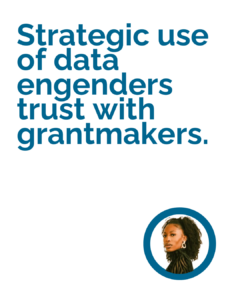 Set Up Automated Reminders
Set Up Automated Reminders
Missing a proposal deadline can mean missing out on funding, whereas missing a reporting deadline can jeopardize your relationship with a grantmaker. Automated calendar reminders for upcoming deadlines, progress reports, and renewal opportunities keep nonprofits on track.
Train Your Team on Data Best Practices
A well-trained team ensures consistency in grant tracking. Regular training on data management best practices helps organizations avoid common pitfalls. Elevate has helped clients implement grant tracking that drastically improved internal coordination and grant success rates through our trained staff.
Regular training can also help organizations adapt to changes in funder expectations. By staying informed on best practices, teams can adjust strategies in real time to improve their success rates.
Conclusion
Accurate and well-managed grant program data is essential for securing funding and building strong relationships with grantmakers. By implementing structured tracking systems, nonprofits can increase efficiency, improve proposal success rates, and maintain compliance with funding partners’ requirements.
At Elevate, we’ve been thinking a lot this year about Artificial Intelligence (AI) and how it could influence the way that we perform our work supporting nonprofits in building more sustainable grants programs. AI is increasingly relevant in everyday business operations across numerous industries, and it has been applied for many years in ways that many people don’t realize – mapping apps like Google Maps, voice assistants like Alexa and Siri, even the autocorrect feature in your texting app or word processing software are powered by artificial intelligence.
Some interesting trends have emerged in 2023, which hint at AI’s potential while also raising significant ethical and information security considerations. A recent Forbes Advisor survey reports that:
- ChatGPT, an AI powered large language model, had 1 million users within the first five days of being available.
- 54% of survey respondents believe that AI tools like ChatGPT can improve written content by enhancing text quality, creativity, and efficiency in various content creation contexts.
- AI is expected to see an annual growth rate of 37.3% between now and 2030.
- The majority of consumers are concerned about business use of AI.
Accordingly, Elevate is treading optimistically – yet cautiously – when it comes to AI! While we are exploring how AI can create efficiencies in our work, we are also committed to maintaining the highest quality and privacy standards for our clients.
I recently spoke with a handful of my most forward-thinking and tech-savvy Elevate colleagues, who offered their thoughts on what AI applications are and aren’t helpful in aspects of their work advising nonprofit clients. We share their insights here for your consideration as we all navigate this brave new world.
Because many of the questions Elevate receives about AI are about ChatGPT specifically, we begin with the 411 on this tool.
Even if you haven’t yet used it yourself, you’ve undoubtedly heard the buzz about ChatGPT. ChatGPT is a free, natural language processing tool that can answer questions and support users with tasks such as composing emails, essays, and code. It can spew out responses in a matter of seconds. It does this by analyzing your question or prompt, then – using the dataset it was trained on – predicting the next word or series of words based on what you’ve entered.
But is it savvy enough to write sophisticated, nuanced, and winning grants?
Our colleagues were unequivocal in their response: Not even close.
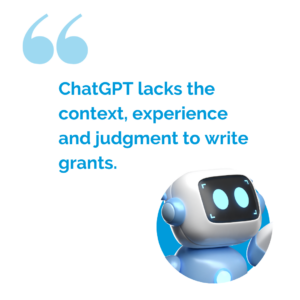 This is because ChatGPT lacks the context, experience and judgment to handle such complex work. Even when I asked ChatGPT “What are the Pros and Cons of Using ChatGPT for grant writing?” it didn’t disagree! While ChatGPT praised its speed and ability to maintain consistency in “tone, language, and messaging” across various sections of a grant proposal and to polish language, it cautioned that it may not fully appreciate the “nuances” of grant guidelines, that it has limitations in understanding the context of an organization’s work and history, and that it could also produce plagiarizing text.
This is because ChatGPT lacks the context, experience and judgment to handle such complex work. Even when I asked ChatGPT “What are the Pros and Cons of Using ChatGPT for grant writing?” it didn’t disagree! While ChatGPT praised its speed and ability to maintain consistency in “tone, language, and messaging” across various sections of a grant proposal and to polish language, it cautioned that it may not fully appreciate the “nuances” of grant guidelines, that it has limitations in understanding the context of an organization’s work and history, and that it could also produce plagiarizing text.
The text that ChatGPT generates in response to a question or prompt might not even be factual – there are absolutely no assurances that the information is accurate or true.
What’s more, because ChatGPT and other AI models draw upon existing content, AI can reflect underlying societal biases, perpetuating stereotypes and white supremacist notions. At Elevate, we know that historically marginalized communities are not “vulnerable” objects of charity, but agents and partners of the social change that they desire to see. This level of social context is far too complex for an AI-powered language model to appropriately reflect.
So, what are the appropriate uses of ChatGPT?
If you do want to experiment with ChatGPT in your writing tasks, we suggest using it for simpler, less analytical tasks, such as condensing word count, identifying alternative phrasing to avoid repetition, or summarizing the main points of your research into more readable language.
ChatGPT also has the potential to provide administrative support for your work, and can be harnessed to:
- Organize a to-do list
- Summarize meeting minutes
- Brainstorm ideas
But whatever you do, do NOT rely on ChatGPT to produce your next grant proposal.
 I know what you are thinking: It’s no surprise that a grant writing firm is telling me not to use an AI tool to write grants! But we are not just saying this because we want to be your grant writers. (Though we DO want to be your grant writers!)
I know what you are thinking: It’s no surprise that a grant writing firm is telling me not to use an AI tool to write grants! But we are not just saying this because we want to be your grant writers. (Though we DO want to be your grant writers!)
At Elevate, we firmly believe that good grant writing is a thoughtful, strategic exercise that requires skill, nuance, and informed decision making. ChatGPT – like other AI tools – is neither thoughtful nor strategic. It lacks discernment of nuance, and is incapable of making reasoned choices about how to present an organization’s work to a funding partner.
Simply producing large volumes of content – that may or may not be factual! – is NOT the point of grant writing. And this is truly all that ChatGPT is doing: generating text.
AI Tools CAN Help You Take Notes, Summarize Content, and Find Information
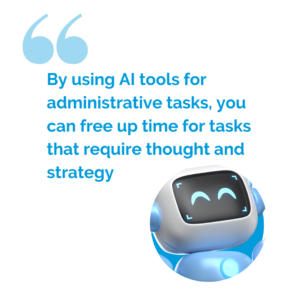 At Elevate, some of our staff are experimenting with the use of AI-powered tools such as Simon Says AI and Fathom Notetaker to capture meeting notes and provide summaries of important conversations that they need to refer back to later or share with colleagues who couldn’t attend meetings. By using AI tools for more administrative tasks, you can free up some of your own time and energy for tasks that require thought and strategy – something AI can’t do!
At Elevate, some of our staff are experimenting with the use of AI-powered tools such as Simon Says AI and Fathom Notetaker to capture meeting notes and provide summaries of important conversations that they need to refer back to later or share with colleagues who couldn’t attend meetings. By using AI tools for more administrative tasks, you can free up some of your own time and energy for tasks that require thought and strategy – something AI can’t do!
As a tool developed by Google, Bard can interface with Google Workspace tools, if you choose to connect these. This means, you can ask Bard to find dates, taks, or other information in gmail, or to summarize a report a colleague shared via Google docs.
Interested in exploring more options for what you can do with AI tools? Check out FutureTools.io, which aggregates AI tools suited for different purposes.
Please Please Please: Inform yourself about privacy!
If you take only one thing away from this article, I hope it is this: get informed about the privacy of the information you share with AI tools, and take precautions to protect your information.
When using any cloud-based technology platform, it is imperative that consideration be given to the way these tools use, store, and share information. Depending on your privacy settings, information you share with tools like Bard and ChatGPT may be used to improve its own language model. This means your data may not only be available to its creators (OpenAI), but also to others who use the platform.
For instance, when first accessing Bard, users are notified that Google will collect conversations and other information like the user’s location, store this data for a period of time, and use it to refine the tool. Furthermore, users are informed that “human reviewers read, annotate, and process your Bard conversations,” and they are warned to not share confidential information.
 For these reasons, think carefully about what information you share with AI tools. Remember that a grant application may include information about your organization, programs, staff, and future plans that might be considered private. A good rule of thumb is, if you wouldn’t want a piece of data or information on your public website for anyone to find, you should not share that information with an AI tool.
For these reasons, think carefully about what information you share with AI tools. Remember that a grant application may include information about your organization, programs, staff, and future plans that might be considered private. A good rule of thumb is, if you wouldn’t want a piece of data or information on your public website for anyone to find, you should not share that information with an AI tool.
How is your organization using AI powered tools, and what have you found useful, scary, hopeful, or exciting about these tools? We invite you to share!
Are you still feeling overwhelmed, or do you want to learn more? Here are a few sources the team at Elevate is using to stay informed:
You might have noticed that Elevate’s tagline is “Smart Grants for Powerful Social Change.”
Elevate works with over 100 inspiring nonprofit organizations that improve people’s lives and communities. This is the “powerful social change” in our tagline, while “Smart Grants” is in part a reference to one of the essential tools that we use to get better at the work we do every day for our clients: data. Understanding what data tells us about our clients’ grant program outcomes is key to our success. Tracking grant-related data is a unique hallmark of Elevate’s services, and one of the features that sets Elevate apart from other fundraising and grants consultants.
Every year, we review the data related to our work and examine trends and highlights. Our year-end infographic, Elevate 2022 by the Numbers, offers a data snapshot of the preceding 12 months. Our mighty staff of 82 served 162 clients, submitted 2,901 deliverables, (i.e., grants, letters of intent, and reports), and won over $132 million for our clients! Last year, we had a 65% win rate for grants prepared by Elevate.
There is much to celebrate about our clients’ significant grant wins last year! But at Elevate, we do more than acknowledge our client’s triumphs: we also look for significant trends and lessons that can better inform our work with both new and long-time partners in the years to come.
Our 2022 Win Rate: 65%
Last year, our clients won 65% of the grants that Elevate wrote on their behalf. This is an extraordinary success rate – we win two-thirds of all grants submitted, more than three times the national average.
This win rate is a conservative calculation. It only includes opportunities that were drafted and submitted by Elevate on behalf of our clients. However, Elevate also provides advice and language on a client’s own submissions, as well as “softer-touch” aspects of support that may ultimately lead to funding wins, including helping clients cultivate new funders and steward relationships with current funders.
We have searched for a comparable national statistic to gauge our 65% win rate. Based on nonprofit self-reporting, information from Foundation Directory, and raw data, Candid estimates a national average win rate of 17%. Other sources place the average win rate somewhere between 10 and 30%. (We wholeheartedly welcome any alternative sources for national win rate data if you wish to reach out to us!)
Stepping back so that we may assess the bigger picture, our own data set reveals that win rates vary based on factors such as a nonprofit’s tenure with Elevate as well as their budget size.
For instance, there is a bit of a ramp-up in building a new grants program: it can take anywhere from nine to 18 months from the point at which an organization first begins researching grant opportunities to the point when they secure their first grants.
When many partners begin working with Elevate, especially if they are new to grants, the first several months are spent getting to know the organization’s needs, collaborating on a suitable grant strategy, identifying funding opportunities, and building a grants calendar.
For this reason, it is really not until these clients enter year 3 with Elevate when win rates start to consistently approach the 65% mark. This is also why our very long standing clients (those who have partnered with us for 7 years or more) have even higher win rates. In collaboration with these organizations, we have systematically built efficient and sustainable grants programs!
Interestingly, Elevate has witnessed a steady uptick in our overall win rate as our organization has matured. We moved from a 55.6% win rate in 2018 to a 60.7% win rate in 2020 to our current rate of 65%. This progression reflects an increased investment in our staff as well as a high-quality operations team to better support them and our clients. (For more on our organizational investments, check out our Founder’s Elevate is Ten! blog post celebrating our decade milestone.)
Our 2022 Total Dollars Won: $132,835,761
In addition to our team’s impressive win rate, we are very proud to share that we won over $132 million for our clients’ work last year!
There are a lot of ways to parse this nine-figure sum secured by Elevate clients. For our Comprehensive Grant Writing Services clients, Elevate and our clients work collaboratively to decide which opportunities to pursue based on their customized grant strategy for a given year. Other clients may opt to utilize one of our project-based services such as our Writing Capacity Projects to add extra grant capacity for a limited time or to apply for a large grant. Clients’ needs also differ based on numerous factors, including their sector (we partner with organizations working in the areas of arts & culture, education, health & human services, advocacy, and international issues, for example), their mix of local and national funders, their budget size (we work with organizations with budgets under $500,000 to those with annual budgets over $50 million).
Therefore, whether it is a $250 award (our smallest in 2022) or a $7.8 million grant (the largest grant we secured last year), all of our wins are vitally important in helping to sustain our clients’ good works. Between these polar extremes, we calculated an average award of $151,000 and a median award of $25,000 among the grants secured in 2022.
Interested in learning more about how Elevate uses data to serve our clients? Check out our blog on how general operating requests have a higher win rate than program-restricted proposals. Also look out for the “March of Project Coordinators” series next month (we also like puns!) that will illustrate the value of data and project management on our client teams.
ABOUT OUR DATA
Elevate uses Salesforce to log thousands of grant opportunities each year across our nearly 100 nonprofit partners. We track information related to which grants are secured and which are lost, how much funding is requested and awarded, whether each grant is for a specific program area or for operating support, and much much more. The results described here come from thousands of data points across all of Elevate’s nonprofit partners. We love data!
August 16, 2022
A 2022 analysis completed by Elevate’s Data Team found that our clients’ win rate for general operating support requests is higher than our win rate for program-specific requests, and that this is true for both new and renewal grants.
Given the continued changes in the sector in 2025 – including serious resource constraints for many nonprofits – we wanted to see if the data is still trending the same way. So, we ran the numbers from a full four years of grant applications – from 2020 through 2024 – which included more than 13,500 proposals! During that time, the win rate for general operating support grants was 73.7% (for every 100 grants submitted, 73 were won), whereas the win rate for program support was 66.1%. This mirrors our findings in 2022. Further, all of the other data points that we examined in 2022 were within a few percentage points and the same in their relationship to each other.
What’s our takeaway? This continuing data shows that funder interest in supporting general operating expenses was not a peak COVID aberration. Now, as nonprofits face extreme uncertainty related to funding from public agencies, it is more important than ever to identify and take advantage of opportunities to request funding that truly meets your organization’s needs.
QUESTIONING ASSUMPTIONS
How many times have you heard fundraising advice along the lines of: “Grant proposals that are focused on a specific project or program are more compelling than those requesting general support.” Or: “Foundations want to support programs, not overhead!”
If you have worked in nonprofit leadership, development, or an adjacent role for any measure of time, I am certain that the answer is likely more than you can count!
But how true is this traditional advice?
In recent years, the team at Elevate has observed key trends in the types of grants our clients are winning. We had a hunch that our nonprofit partners were securing more general operating support dollars each year, and that grantmakers are warming to the idea of providing general operating support. And we saw the think pieces; read any listicle on the “top trends in grantmaking” and you’ll undoubtedly see increased general operating support and trust-based philanthropy on top of the list.
Still, we wondered what our own data would reveal. Are Elevate clients winning more general operating support or programmatic grants? How does the amount of grant revenue they secure compare between the two? And is it possible to secure general operating support from a new funding partner, or should we only ask our existing donors for general operating support? So we rolled up our sleeves, typed in our two-factor authentication codes, and dug into our trusty Salesforce database for the answers.
WHAT WE LEARNED
Elevate and our clients win a higher percentage of the General Operating Support grants we submit compared to Program-Restricted grants.
We looked at the overall win rate – the grants secured compared to the total number of grants submitted – for both general operating support and for program support for the two-and-a-half year period from January 1, 2020 to June 30, 2022. During that period, our clients submitted a total of 6,229 proposals. The win rate for general operating support grants was 72.2% (for every 100 grants submitted, 72 were won), whereas the win rate for program support was 66.8%. While this may seem modest, we actually ran a chi-square test to ensure that these results were statistically significant (p < .0001), and not due to random variation. The findings were clear: there are real differences in win rate by request type.
Even when disaggregated by new and renewal grants, win rates are STILL higher for General Operating Support requests.
After examining the above, we wondered whether the result would be different if we broke the opportunities apart by new versus renewal opportunities. An opportunity would be considered “new” if it is one that the organization has never applied to in the past, and a renewal opportunity is a grant they have secured in previous years. Generally, a grantee has a much higher likelihood of securing a renewal grant than a new one. (You already know this if you read our two-part blog on How to Predict the Future!) But we wondered about the likelihood of securing a new grant for General Operating Support.
Interestingly, our findings held true for both new and renewal opportunities. For renewal grant opportunities, the win rate for General Operating Support requests was 92.2%, slightly higher than the win rate for program requests at 87.8%. For new grant opportunities, the win rate for General Operating Support requests was 54.3%, and the win rate for program requests was 47.1%.

On the flip side, the total dollars secured for Program-Restricted grants is more than twice that of General Operating Support.
While the data around win rates is very compelling, we also wondered about the total grant dollars our nonprofit partners secure that is designated as general operating support versus program-restricted funding. Interestingly, for the same set of opportunities that resulted in the win rates in findings #1 and #2 above, our clients secured roughly $370.3 million in programmatic support, as compared with $169.8 million in general operating support – less than half of the total amount of programmatic funding won!

Naturally, we wondered why this is the case, which lead us to our final finding: overall, there are more opportunities to request Program-Restricted grants than there are opportunities to ask for General Operating Support.
While win rates may be higher for general operating support grants, the opportunity to request this type of flexible support is not the norm. Our data set revealed that Elevate clients had nearly 25% more opportunities to request program support than they had opportunities to ask for general operating support.

OUR THOUGHTS ON THE FINDINGS
Our analysis shows how important general operating support is to a holistic grant strategy. And, it shows how our nonprofit clients are both empowered to ask for what they most need, and able to find true philanthropic partners willing to invest in the sustainability and capacity of their organizations.
Still, across the board, foundations invest more dollars in programs than in the operations of their grantees. We view this as a fundamental problem facing our sector today: many philanthropists are unwilling to invest in the necessary infrastructure of nonprofits. And as any nonprofit leader knows all too well, without unrestricted funding to invest in staff, technology, capacity building, anti-racism work, and unanticipated opportunities, nonprofits are hamstrung, unable to innovate or act swiftly to serve their community or constituents when the need arises.
The bottom line is that general operating support is essential to the success of the nonprofit sector. Organizations need flexible funding that they can leverage as needed to advance their missions. And they need more funding partners who are willing to trust nonprofit leaders and invest in organizations in a way that allows them to do their work.
We are hopeful: the data is pointing in the right direction. And, philanthropy must continue to invest even more unrestricted resources in the nonprofits doing the meaningful work of social change.
ABOUT OUR DATA
Elevate uses Salesforce to log thousands of grant opportunities each year across our nearly 100 nonprofit partners. We track information related to which grants are secured and which are lost, how much funding is requested and awarded, whether each grant is for a specific program area or for operating support, and much much more. The results described here come from thousands of data points across all of Elevate’s nonprofit partners. We love data!
June 14, 2022
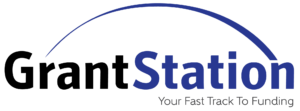 Our friends at GrantStation surveyed more than 1,750 representatives of the nonprofit community about grant seeking at their organizations and published a comprehensive report of the findings. The data covers a wide range of topics relating to how organizations tackle grants, the time and resources they invest in their grants programs, the impact of these efforts in terms of grants won and dollars raised, and some of the challenges organizations face in their pursuit of grant funding.
Our friends at GrantStation surveyed more than 1,750 representatives of the nonprofit community about grant seeking at their organizations and published a comprehensive report of the findings. The data covers a wide range of topics relating to how organizations tackle grants, the time and resources they invest in their grants programs, the impact of these efforts in terms of grants won and dollars raised, and some of the challenges organizations face in their pursuit of grant funding.
At Elevate, we have partnered with hundreds of nonprofits to implement effective grants programs, and much of the findings of the State of Grantseeking Survey resonate with our experience. Here are a few of the key data points that caught our attention in this year’s report.
Most organizations report that the grant cycle for their largest grants was between one and six months from when the proposal was submitted to the day they were notified of their award.
This aligns closely with Elevate clients’ experience. While many foundations make funding decisions at Board meetings held on an annual, semi-annual, or quarterly basis, others have more flexible review processes that allow them to make funding decisions quickly. We find that well-cultivated opportunities with more progressive, less bureaucratic funders tend to have the quickest turn-around times. However, in most cases you can expect a response to your grant request on a slightly longer timeframe – 4 to 6 months after a proposal submission.
It takes a lot of staff capacity to prepare a strong grant! 63% of organizations report that 1-2 staff worked on their largest grant requests, while 25% of organizations have 3-5 staff directly involved in the grantseeking process.
It’s worth noting that having more individuals involved is not necessarily a bad thing – by engaging your finance, programs, executive, and other staff in the preparation of a funding request, you can build an effective culture of philanthropy where everyone sees themselves as playing a role in securing the resources needed to implement your organization’s mission. Further, once the funds are secured, you will already have a team in place that understands the proposed activities and outcomes associated with the grant and that is ready to implement!”
Grant writing takes time! Most organizations report spending between two days and two weeks writing a grant application.
When planning to develop a proposal, you’ll need to allocate time to review the application questions or proposal requirements, collect data, stories, and activities from your team, prepare budgets and other attachments, and write the narrative. And we always recommend allowing time for a thorough review – for strategic alignment, clarity, and basic grammar as well as adherence to proposal requirements. We explore much of this planning process in our FREE How to Write Your First Grant webinar.
Relatedly, one of the biggest hurdles for organizations in the grantseeking process is a lack of time and staff capacity to research, write, and submit grants.
However, making an investment of this time and capacity is crucial for the long-term success and sustainability of your grants program. We find that organizations without dedicated expertise (either having grants experts on staff or the advice of an external consultant) and dedicated time (again – internal or external) are far less likely to secure significant revenue from grants. Aside from the time it takes to prepare grants, other challenges nonprofits face in pursuing grant funding include specific funder requirements, competition among peers, and finding well-aligned opportunities. While many of these barriers can be reduced by committing the appropriate resources to your grants program, the bottom line is that building a winning grants program is tough! It takes capacity, expertise, collaboration, hard work, and time to secure funding from grants. Are you interested in learning more about how the grant writing experts at Elevate can help you develop a sustainable and winning grants program? We’d love to hear from you! Reach out to us today to learn more!
November 16, 2021
While many articles about fundraising during the pandemic have focused on record-breaking philanthropy from foundations, we know that emergency pandemic funding required some record-breaking grant writing and fundraising as well.
On behalf of roughly 80 of our nonprofit clients, Elevate drafted and submitted more than 400 requests for dedicated COVID-19 emergency response funds. Below is an analysis from our Data Team about what we have learned since March 2020.
Elevate’s nonprofit clients saw their grant requests sky-rocket, increasing 71% over the previous year. Elevate’s clients drafted 758 fundraising deliverables in the Spring of 2020, compared to 442 in Spring 2019. These deliverables included both letters of inquiry and detailed applications.
And, this happened fast: by the end of March, clients had submitted 10% of their COVID-19 emergency response requests. By the end of June, 60% of their rapid response solicitations were already in funders’ hands.
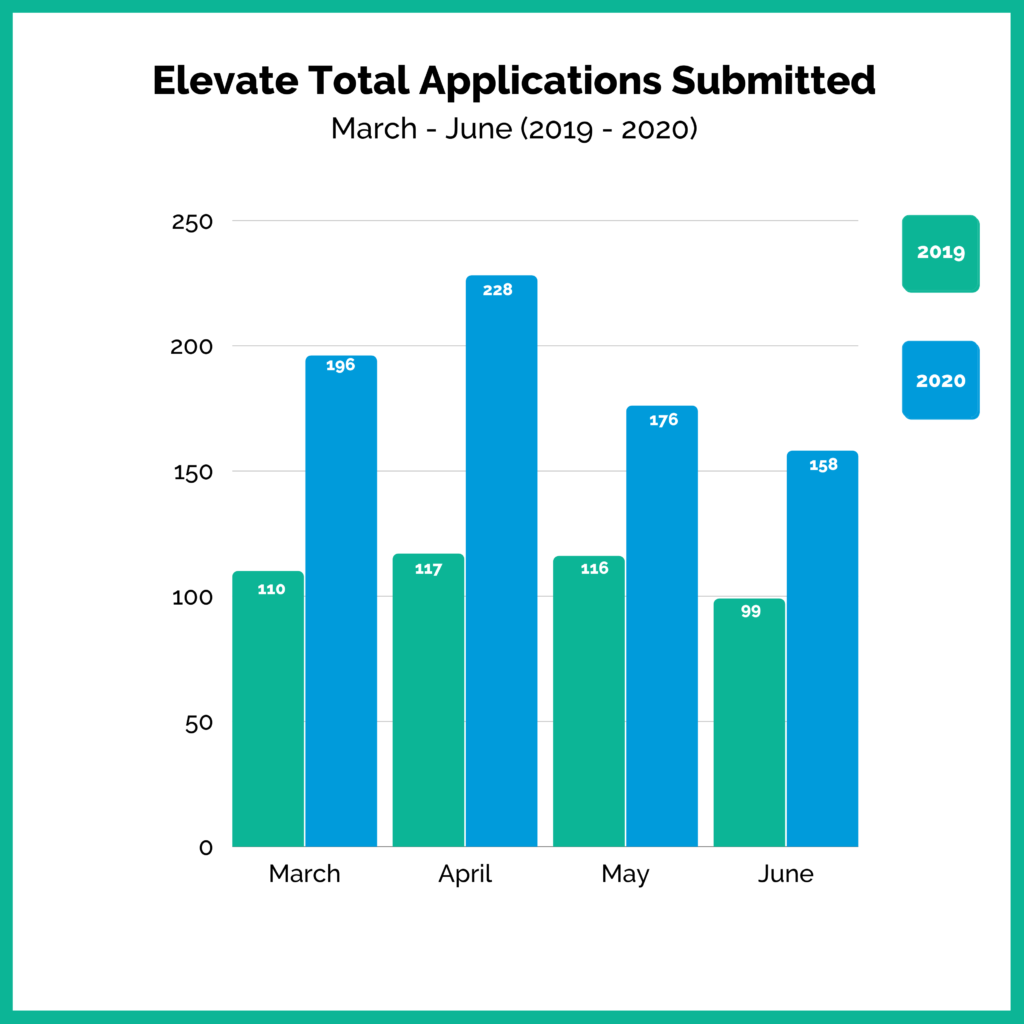
Elevate’s nonprofit clients won 58% of all COVID-19 grants.
This aligns closely to Elevate’s standard win rate, which has ranged between 58% and 62% over the last five years. This illustrates how our clients worked hard to avoid leaving money on the table, with our support. We were able to quickly identify pandemic-related needs with our clients in order to pursue emergency response funding that wasn’t always a “sure thing” in order to mitigate short-term financial concerns at the beginning of the pandemic. From a closer look at Elevate’s specific data set, we also found that:
Organizations in the health and human services sector received the majority of COVID-19 response funds.
Since March 2020, health, human services, and housing clients secured $3.9 million in COVID-19 response funding, which represents almost 58% of total COVID-19 funding awarded to Elevate clients. This trends slightly above the percentage COVID-19 response funding distributed nationwide to health and human services nonprofits (54%) according to data compiled by CANDID and the Center for Disaster Philanthropy.
Additionally, Elevate’s clients secured more COVID-19 response funding for advocacy and systems change organizations than was typical of national trends.
According to Philanthropy and COVID-19, published by CANDID and Center for Disaster Philanthropy in 2021, 9% of COVID-19 response dollars addressed advocacy and systems change. At Elevate, our policy advocacy and grassroots organizing nonprofits secured 20% of all COVID-19 response funding¹.
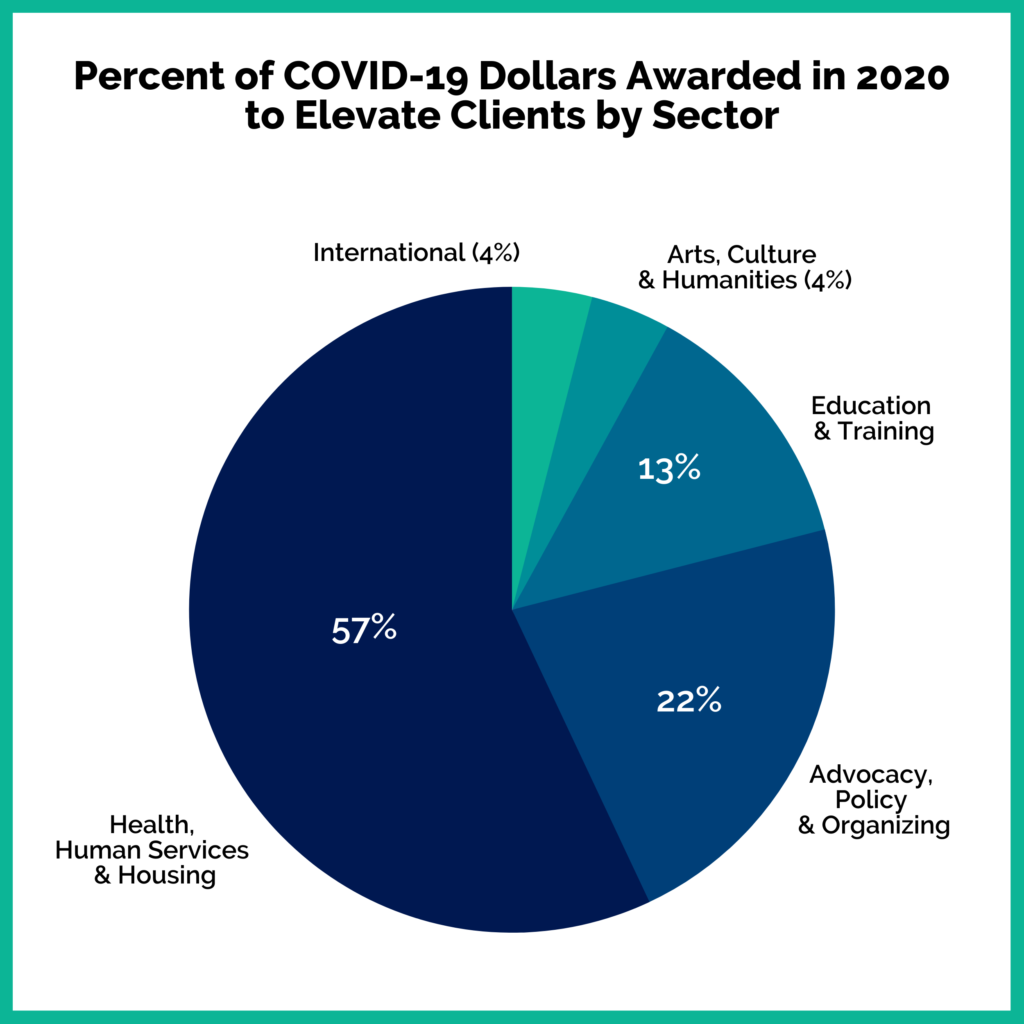
As of today, we are past the peak of COVID-19 recovery funding.
The number of COVID-19 opportunities per quarter dropped from 79 in the first year of the pandemic to 14 submitted and planned in the second year.
Nevertheless: Elevate and our clients are still reporting on the many COVID-related funds!
COVID-19 response reporting was at its highest in the last quarter of 2020 (October – December), but we are still averaging 19 reports per quarter through the first quarter of 2022. The good news is that it’s clear that funders are waiving many of the reporting requirements on COVID-19 response funding: there are far fewer reports than there are proposals tied to this specific funding stream.
While this data demonstrates our clients’ success during the peak of COVID-19 funding opportunities, it’s also important to interpret what the data is indicating for future planning — particularly when nonprofits aren’t necessarily back to business as usual and many foundations have returned to pre-pandemic funding practices. We look forward to continuing to share our thoughts about what all of this means for fundraising strategy moving forward.
Written by Kelsey Neilson and Rachel Saint-Firmin






 For example, one Elevate client had gaps in their grant calendar where they should have had grant report deadlines. We discovered this was due to missing and poorly tracked grant agreements – where the information about reporting requirements could be found! This information gap led to several missed report deadlines, putting our client’s funder relationships at risk and delaying new funding (because reporting was required before grants could be renewed.
For example, one Elevate client had gaps in their grant calendar where they should have had grant report deadlines. We discovered this was due to missing and poorly tracked grant agreements – where the information about reporting requirements could be found! This information gap led to several missed report deadlines, putting our client’s funder relationships at risk and delaying new funding (because reporting was required before grants could be renewed. Staff turnover can lead to the loss of critical grant program data. Without a structured system, new team members may struggle to pick up where others left off. Establishing clear documentation, standards, and processes mitigates this risk and allows for smoother transitions between teams.
Staff turnover can lead to the loss of critical grant program data. Without a structured system, new team members may struggle to pick up where others left off. Establishing clear documentation, standards, and processes mitigates this risk and allows for smoother transitions between teams. Set Up Automated Reminders
Set Up Automated Reminders This is because ChatGPT lacks the context, experience and judgment to handle such complex work. Even when I asked ChatGPT “What are the Pros and Cons of Using ChatGPT for grant writing?” it didn’t disagree! While ChatGPT praised its speed and ability to maintain consistency in “tone, language, and messaging” across various sections of a grant proposal and to polish language, it cautioned that it may not fully appreciate the “nuances” of grant guidelines, that it has limitations in understanding the context of an organization’s work and history, and that it could also produce plagiarizing text.
This is because ChatGPT lacks the context, experience and judgment to handle such complex work. Even when I asked ChatGPT “What are the Pros and Cons of Using ChatGPT for grant writing?” it didn’t disagree! While ChatGPT praised its speed and ability to maintain consistency in “tone, language, and messaging” across various sections of a grant proposal and to polish language, it cautioned that it may not fully appreciate the “nuances” of grant guidelines, that it has limitations in understanding the context of an organization’s work and history, and that it could also produce plagiarizing text.  I know what you are thinking: It’s no surprise that a grant writing firm is telling me not to use an AI tool to write grants! But we are not just saying this because we want to be your grant writers. (Though we DO want to be your grant writers!)
I know what you are thinking: It’s no surprise that a grant writing firm is telling me not to use an AI tool to write grants! But we are not just saying this because we want to be your grant writers. (Though we DO want to be your grant writers!)  At Elevate, some of our staff are experimenting with the use of AI-powered tools such as
At Elevate, some of our staff are experimenting with the use of AI-powered tools such as  For these reasons, think carefully about what information you share with AI tools. Remember that a grant application may include information about your organization, programs, staff, and future plans that might be considered private.
For these reasons, think carefully about what information you share with AI tools. Remember that a grant application may include information about your organization, programs, staff, and future plans that might be considered private.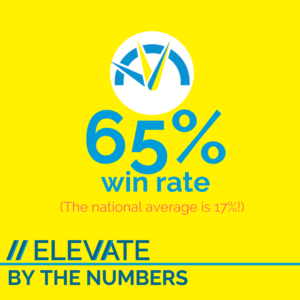

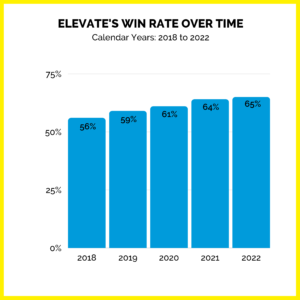
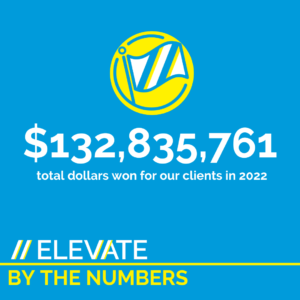




 Our friends at GrantStation surveyed more than 1,750 representatives of the nonprofit community about grant seeking at their organizations and published a comprehensive report of the findings. The data covers a wide range of topics relating to how organizations tackle grants, the time and resources they invest in their grants programs, the impact of these efforts in terms of grants won and dollars raised, and some of the challenges organizations face in their pursuit of grant funding.
Our friends at GrantStation surveyed more than 1,750 representatives of the nonprofit community about grant seeking at their organizations and published a comprehensive report of the findings. The data covers a wide range of topics relating to how organizations tackle grants, the time and resources they invest in their grants programs, the impact of these efforts in terms of grants won and dollars raised, and some of the challenges organizations face in their pursuit of grant funding.

